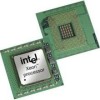Intel BX80605X3430 Data Sheet - Page 39
Requesting Low-Power Idle States, Core C-states
 |
UPC - 735858210331
View all Intel BX80605X3430 manuals
Add to My Manuals
Save this manual to your list of manuals |
Page 39 highlights
Power Management 4.2.3 Requesting Low-Power Idle States The primary software interfaces for requesting low-power idle states are through the MWAIT instruction with sub-state hints and the HLT instruction (for C1 and C1E). However, software may make C-state requests using the legacy method of I/O reads from the ACPI-defined processor clock control registers, referred to as P_LVLx. This method of requesting C-states provides legacy support for operating systems that initiate C-state transitions using I/O reads. For legacy operating systems, P_LVLx I/O reads are converted within the processor to the equivalent MWAIT C-state request. Therefore, P_LVLx reads do not directly result in I/O reads to the system. The feature, known as I/O MWAIT redirection, must be enabled in the BIOS. Note: The P_LVLx I/O Monitor address needs to be set up before using the P_LVLx I/O read interface. Each P-LVLx is mapped to the supported MWAIT(Cx) instruction as follows: Table 4-4. P_LVLx to MWAIT Conversion P_LVLx P_LVL2 P_LVL3 MWAIT(Cx) MWAIT(C3) MWAIT(C6) C6. No sub-states allowed Notes The BIOS can write to the C-state range field of the PMG_IO_CAPTURE MSR to restrict the range of I/O addresses that are trapped and emulate MWAIT like functionality. Any P_LVLx reads outside of this range does not cause an I/O redirection to MWAIT(Cx) like request. They fall through like a normal I/O instruction. Note: When P_LVLx I/O instructions are used, MWAIT substates cannot be defined. The MWAIT substate is always zero if I/O MWAIT redirection is used. By default, P_LVLx I/O redirections enable the MWAIT 'break on EFLAGS.IF' feature that triggers a wakeup on an interrupt, even if interrupts are masked by EFLAGS.IF. 4.2.4 Core C-states The following are general rules for all core C-states, unless specified otherwise: • A core C-State is determined by the lowest numerical thread state (such that, Thread 0 requests C1E while thread1 requests C3, resulting in a core C1E state). See Table 4-3. • A core transitions to C0 state when: - an interrupt occurs. - there is an access to the monitored address if the state was entered using an MWAIT instruction. • For core C1/C1E, and core C3, an interrupt directed toward a single thread wakes only that thread. However, since both threads are no longer at the same core Cstate, the core resolves to C0. • For core C6, an interrupt coming into either thread wakes both threads into C0 state. • Any interrupt coming into the processor package may wake any core. Datasheet, Volume 1 39















